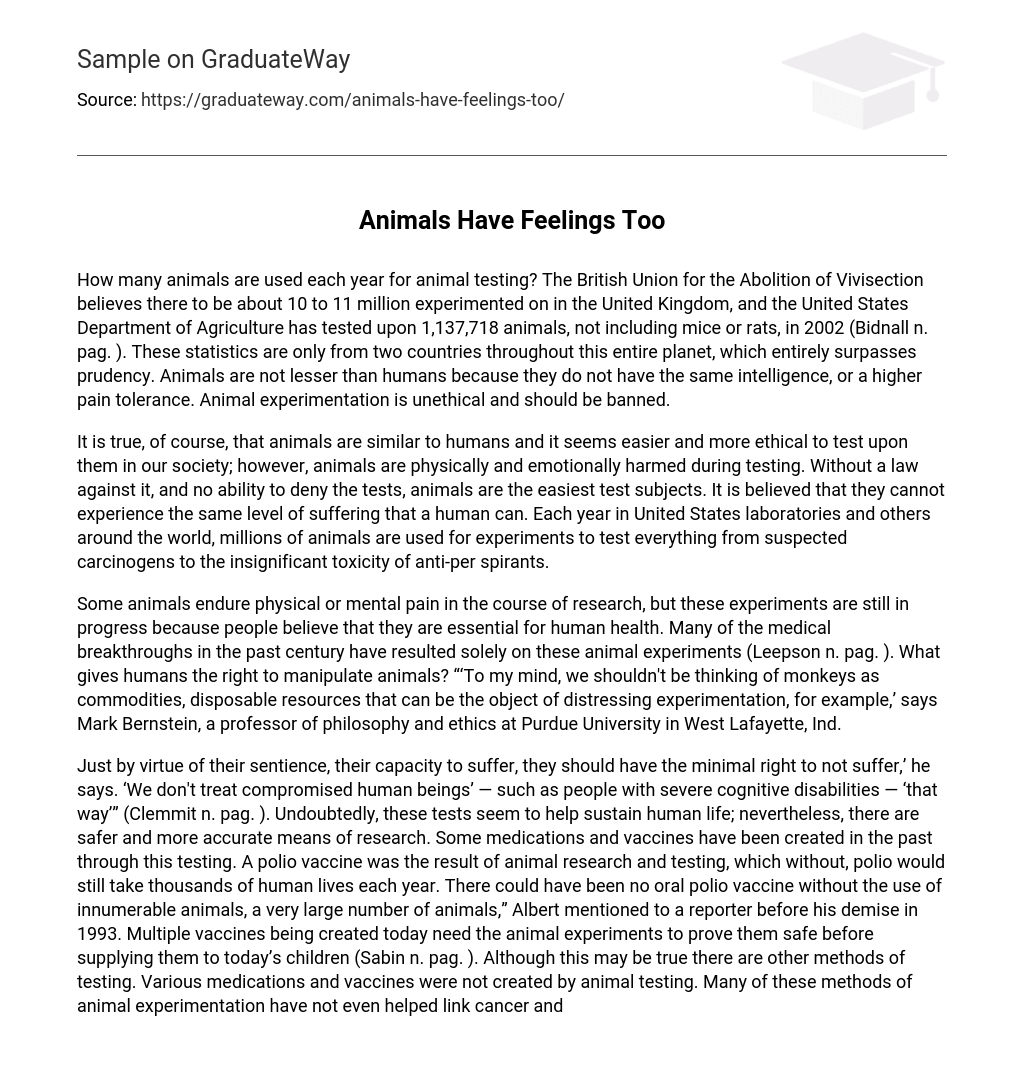The number of animals used for animal testing each year is a cause for concern. According to the British Union for the Abolition of Vivisection, around 10 to 11 million animals undergo experimentation in the United Kingdom (Bidnall n. pag.). In 2002, excluding mice and rats, the United States Department of Agriculture conducted tests on 1,137,718 animals (Bidnall n. pag.). These statistics from just two countries are alarming and emphasize the need for action. It is essential to recognize that animals possess equal intelligence and pain tolerance as humans do. As a result, conducting experiments on animals is morally incorrect and should be prohibited.
Despite the similarities between animals and humans, testing on them may appear more convenient and ethical. However, it is crucial to recognize that these tests inflict physical and emotional suffering upon animals. The absence of legislation against such practices, coupled with animals’ inability to refuse, often results in their selection as test subjects. Regrettably, there exists a prevailing belief that animals do not undergo the same level of distress as humans. Consequently, laboratories worldwide, including those in the United States, employ millions of animals annually for experiments spanning from investigating potential carcinogens to evaluating the minimum toxicity levels of anti-perspirants.
Although animals used in research may experience physical or psychological distress, these experiments are deemed necessary for human well-being. The significance of animal studies is evident in numerous medical advancements made in the past century (Leepson n. pag.). However, Mark Bernstein, a philosophy and ethics professor at Purdue University in West Lafayette, Ind., opposes the perspective that animals can be seen as disposable resources for painful experimentation. According to Bernstein (cited in Leepson), monkeys should not be treated merely as commodities.
According to Clemmit, it is argued that sentient beings should have the basic right to not suffer, regardless of their cognitive abilities. He points out that we do not subject compromised humans, such as those with severe cognitive disabilities, to this kind of treatment.
While animal testing appears to contribute to sustaining human life, there are safer and more precise alternatives for research. Albert believes that certain medications and vaccines have been developed through animal testing, like the polio vaccine. Without these tests, polio would continue to claim thousands of human lives annually. Albert emphasized the significant contribution of numerous animals in the development of the oral polio vaccine.
Presently, multiple vaccines require animal experiments for safety verification before they are administered to children, as Sabin reports.
Although it can be argued that some medications and vaccines were not developed through animal testing, there are other methods available. Additionally, certain animal experimentation methods have failed to establish a direct link between cancer and smoking.
Epidemiological studies have connected heart disease and cholesterol in humans, but the effectiveness of animal-tested medications has been questionable, as many have been withdrawn or had their labels revised due to unforeseen side effects. Even AIDS research involving primates has proven to be largely unsuccessful. It is crucial for scientists to employ more dependable methods like vitro testing, modeling studies, and clinical research instead of relying solely on animal experimentation. The use of animal testing is primarily driven by financial gains, but companies are now starting to recognize the problems associated with it.
For the past thirteen years, Choose Cruelty Free has raised awareness about product testing and the importance of choosing a “cruelty-free” lifestyle. This has led to increased recognition of companies’ behaviors in relation to animal cruelty (Wilson n. pag.). While some argue that animal testing is necessary for research, it is crucial to acknowledge that animals should have equal rights to humans. We have the ability to utilize alternatives throughout the process of drug and vaccine discovery and testing, ensuring that we make refined choices before involving animals and humans.
According to Corey (n. pag.), it is necessary to use animal resources in the process of developing novel therapies and vaccines for human disease, in order to improve human and animal health. The Animal Rights movement aims to highlight the similarities between slavery, women’s suffrage, and animal ownership, demonstrating that humans contribute to ethnocentrism by believing that other animals have a lower status in life than humans do. Clemmit (n. pag.) argues that the status of humans should be equal to or lower than that of other animals.





